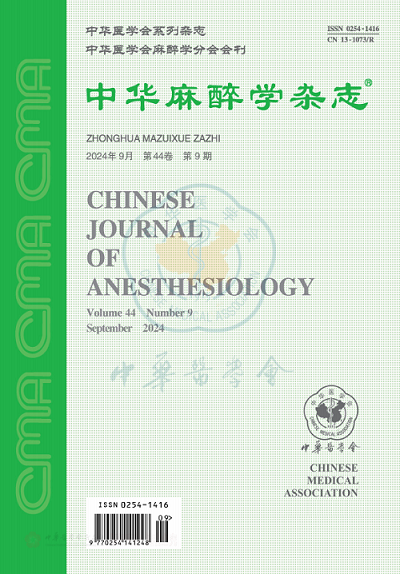Role of spinal COX-1 and COX-2 in remifentanil-induced hyperalgesia in mice with incisional pain
Q4 Medicine
引用次数: 0
Abstract
Objective To evaluate the role of spinal COX-1 and COX-2 in remifentanil-induced hyperalgesia in mice with incisional pain. Methods Thirty-two male C57BL/6J mice, aged 8-10 weeks, weighing 20-25 g, were divided into 4 groups (n=8 each) using a random number table method: control group (group C), incisional pain plus remifentanil group (group IR), incisional pain plus remifentanil plus selective COX-1 inhibitor group (group IR+ SC560), and incisional pain plus remifentanil plus selective COX-2 inhibitor group (group IR+ SC236). In IR, IR+ SC560 and IR+ SC236 groups, normal saline 10 μl, SC560 25 μg and SC236 25 μg were intrathecally injected, respectively, 15 min later remifentanil 10 μg/kg was injected via the tail vein for 4 times at 15 min intervals.An incisional pain model was established after the first injection of remifentanil.The mechanical paw withdrawal threshold (MWT) was measured at 24 h before normal saline or remifentanil injection and 3, 6, 24 and 48 h after the last injection (T0-T4). The mice were sacrificed after the last measurement of pain threshold, and the L4-6 segments of the spinal cord were removed for determination of the expression of COX-1 and COX-2 (by Western blot) and expression of COX-1 and COX-2 mRNA (by quantitative real-time polymerase chain reaction). Results Compared with group C, the MWT was significantly decreased, and the expression of COX-2 protein and mRNA was up-regulated in IR, IR+ SC560 and IR+ SC236 groups (P 0.05) .There was no significant difference in the expression of COX-2 protein and mRNA among group IR, group IR+ SC560 and group IR+ SC236 (P>0.05). There was no significant difference in the expression of COX-1 protein and mRNA among the four groups (P>0.05). Conclusion Compared with COX-1, spinal COX-2 plays a major role in the pathophysiological mechanism of remifentanil-induced hyperalgesia in mice with incisional pain. Key words: Prostaglandin-endoperoxide synthases; Piperidines; Pain, postoperative; Hyperalgesia脊髓COX-1和COX-2在瑞芬太尼诱导的切口痛小鼠痛觉过敏中的作用
目的探讨脊髓COX-1和COX-2在瑞芬太尼诱导的小鼠切口痛痛觉过敏中的作用。方法32只雄性C57BL/6J小鼠,年龄8-10周,体重20-25g,采用随机数表法分为4组(每组8只):对照组(C组)、切口痛加瑞芬太尼组(IR组)、切开痛加瑞芬芬太尼加选择性COX-1抑制剂组(IR+SC560组),切口疼痛加瑞芬太尼加选择性COX-2抑制剂组(IR+SC236组)。IR组、IR+SC560组和IR+SC236组分别鞘内注射生理盐水10μl、SC560 25μg和SC236 25μg,15分钟后经尾静脉注射瑞芬太尼10μg/kg,间隔15分钟4次。首次注射瑞芬太尼后建立切口疼痛模型。在生理盐水或瑞芬太尼注射前24小时以及最后一次注射后3、6、24和48小时(T0-T4)测量机械缩爪阈值(MWT)。在最后一次测量疼痛阈值后处死小鼠,并去除脊髓的L4-6段以测定COX-1和COX-2的表达(通过Western印迹)以及COX-1和COX-2mRNA的表达(利用定量实时聚合酶链反应)。结果IR组、IR+SC560组和IR+SC236组与C组相比MWT明显降低,COX-2蛋白和mRNA表达上调(P<0.05),结论与COX-1相比,脊髓COX-2在瑞芬太尼致小鼠切口痛痛觉过敏的病理生理机制中起重要作用。关键词:前列腺素内过氧化物合成酶;哌啶;疼痛,术后;痛觉过敏
本文章由计算机程序翻译,如有差异,请以英文原文为准。
求助全文
约1分钟内获得全文
求助全文

 求助内容:
求助内容: 应助结果提醒方式:
应助结果提醒方式:


